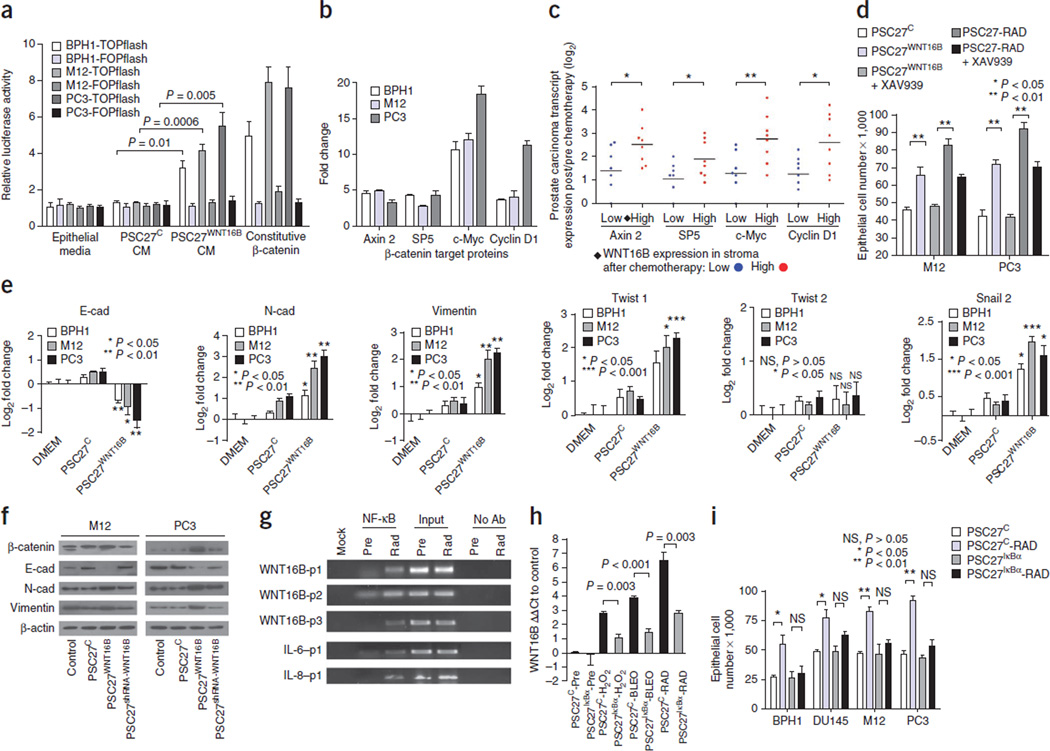Figure 4.
Genotoxic stress upregulates WNT16B through NF-κB and signals through the canonical Wnt–β-catenin pathway to promote tumor cell proliferation and the acquisition of mesenchymal characteristics. (a) Assay of canonical Wnt pathway signaling through activation of a TCF/LEF luciferase reporter construct (TOPflash) or a control reporter (FOPflash). Epithelial cells were exposed to conditioned medium (CM) from PSC27 prostate fibroblasts expressing WNT16B (PSC27WNT16B) or control vector (PSC27C). Data are mean ± s.e.m. of triplicates, and P values were determined by ANOVA followed by t test. (b) qRT-PCR assessment of the expression of β-catenin target genes in prostate cancer cell lines (BPH1, M12 and PC3) before and 72 h after exposure to PSC27WNT16B-conditioned medium. Data represent the mean ± s.e.m. fold change after as compared to before exposure for three replicates. (c) Expression of β-catenin target genes in human prostate cancers in vivo after neoadjuvant treatment with MIT and DOC. Log2 transcript amounts in carcinoma cells after and before chemotherapy are shown in relation to low (blue) or high (red) WNT16B expression in the prostate stroma. Each data point represents an individual patient; n = 8 patients. Horizontal bars are group means. *P < 0.05, **P < 0.01 by ANOVA followed by t test. (d) The β-catenin pathway inhibitor XAV939 suppresses the proliferation of prostate cancer cells in response to PSC27WNT16B CM and attenuates the response to the full DDSP in PSC27-RAD–conditioned medium. Cell numbers were determined 72 h after treatment. (e) Quantification of transcripts in neoplastic prostate epithelial cells encoding proteins associated with a phenotype of EMT. Measurements are from epithelial cells exposed to control media (DMEM), media conditioned by PSC27 fibroblasts (PSC27C) or PSC27 fibroblasts expressing WNT16B (PSC27WNT16B). E-cad, E-cadherin; N-cad, N-cadherin. (f) Analysis of EMT-associated protein expression by western blot. M12 or PC3 cells were exposed to control media, media conditioned by PSC27 fibroblasts (PSC27C), PSC27 fibroblasts expressing WNT16B (PSC27WNT16B) or PSC27 fibroblasts expressing WNT16B and shRNA targeting WNT16B (PSC27shRNA-WNT16B). (g) Chromatin immunoprecipitation assays identified NF-κB binding sites within the proximal promoter of the WNT16 gene. PCR reaction products from Mock (no DNA loading), NF-κB immunoprecipitation, input control DNA and no antibody (Ab) control before treatment (Pre) and after irradiation (Rad). p1, p2 and p3 indicate primer pairs corresponding to putative NF-κB binding regions in WNT16, IL-6 and IL-8, respectively (see the Supplementary Methods for the primer sequences). (h) Analysis of WNT16B transcript expression by qRT-PCR in PSC27 prostate fibroblasts with (PSC27IκBα) or without (PSC27C) inhibition of NF-κB signaling before and after DNA-damaging exposures. (i) Inhibition of NF-κB signaling in fibroblasts responding to DNA damage attenuates the effect of the DDSP on tumor cell proliferation. Cell numbers were determined 72 h after RAD exposure to conditioned medium from fibroblasts with (PSC27IκBα) or without (PSC27C) inhibition of NF-κB signaling. Data in d, e, h and i are mean ± s.e.m. of triplicates, and P values were determined by ANOVA followed by t test.

